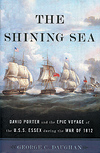
The Shining Sea: David Porter and the Epic Voyage of the U.S.S. Essex During the War of 1812, George C. Daughan, Basic Books, New York, N.Y., 2013, $29.99
As superlatives, “hero” and “epic” are somewhat overused these days. It seems as though every member of the armed forces and the police and fire departments, indeed anyone who aids a stranger experiencing any sort of difficulty, is now labeled a “hero.” Likewise, any slightly strenuous endeavor is labeled as “epic.” The words have been overused to the point of losing their true meaning. In the case of Captain David Porter and his 17-month Pacific voyage on USS Essex, however, the words “hero” and “epic” are applicable without any risk of hyperbole.
George Daughan’s new book recounts Porter’s extraordinary life and his frigate’s initially successful but ultimately tragic voyage to the Pacific Ocean. It reads like something out of the novels of C.S. Forester or Patrick O’Brian, with a bit of Herman Melville’s Typee thrown in for good measure. In Porter’s case, however, the story is true.
The son of a noted Revolutionary War privateer, Porter went to sea at age 16 and, after experiencing enough adventure to last most people a lifetime, joined the U.S. Navy as a midshipman at age 18, just in time to serve in the Quasi-War with France aboard the frigate USS Constellation, on which Porter distinguished himself during the capture of the French frigate Insurgente. He was first lieutenant on the frigate USS Philadelphia when it ran aground in Tripoli in 1803, and he spent 19 months as a prisoner of war.
When the War of 1812 broke out, Porter was in command of Essex. He quickly put to sea and over the next three months seized 11 merchant ships as well as HMS Alert, the first British warship captured during the conflict. Outsailing the British blockade, he then brought Essex safely home.
Porter received orders to put Essex back into shape as soon as possible in order to rendezvous with Constitution and Hornet, which were already cruising in the South Atlantic. A fateful clause in Porter’s orders directed that in the event he failed to meet his consorts, he was to “act according to your best judgment for the good of the service on which we are engaged.” He failed to locate the rest of the squadron, so, acting on his own initiative as instructed, Porter took his ship around Cape Horn into the South Pacific, where he captured 11 British whalers. He also took possession of the Marquesas Islands in the name of the United States, an act unquestionably outside the scope of his orders. After a spectacularly successful cruise, Essex was finally trapped at Valparaíso, Chile, by the British frigates Phoebe and Cherub, which captured it after a furious battle in which all but a handful of Essex’s crew was killed or wounded or went missing.
Historian Daughan makes the case that, like a classical Greek hero, Porter was a victim of hubris. Though undeniably a capable captain, he was undone by overweening ambition and a desire for self-aggrandizement. Daughan believes the relatively small Essex, which was armed almost exclusively with short-ranged carronades, was no match for even one of its cannon-armed adversaries, let alone two working in tandem. The author notes that before Essex sailed, Porter did write to the Department of the Navy to complain specifically about the inadequate nature of his ship’s armament. With a war on and warships in short supply, however, the Navy allowed Porter no time to remedy the situation.
Although a work of history, The Shining Sea reads like an adventure novel, replete with pirates, sea fights and exotic locales. Those interested in learning about the War of 1812 and the fighting Age of Sail will appreciate this book. So, too, will fans of the fictitious adventures of the likes of Horatio Hornblower and Captain Jack Aubrey, for whose authors the exploits of Captain David Porter might well have served as an inspiration.
—Robert Guttman




